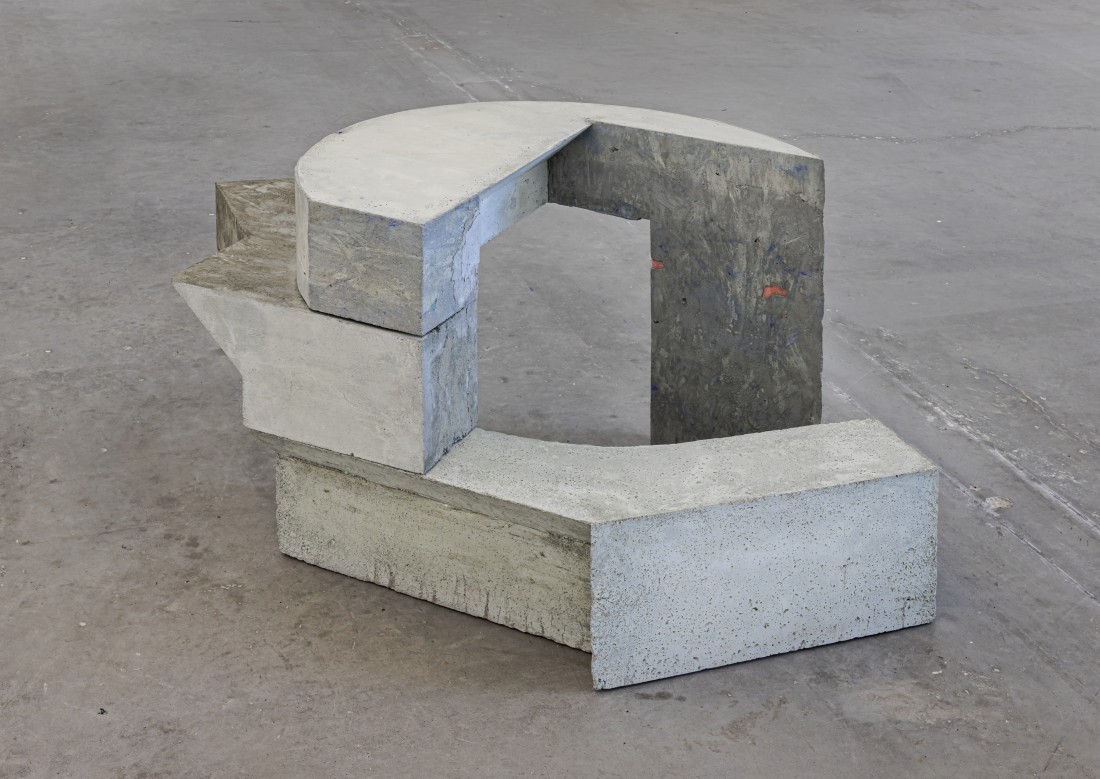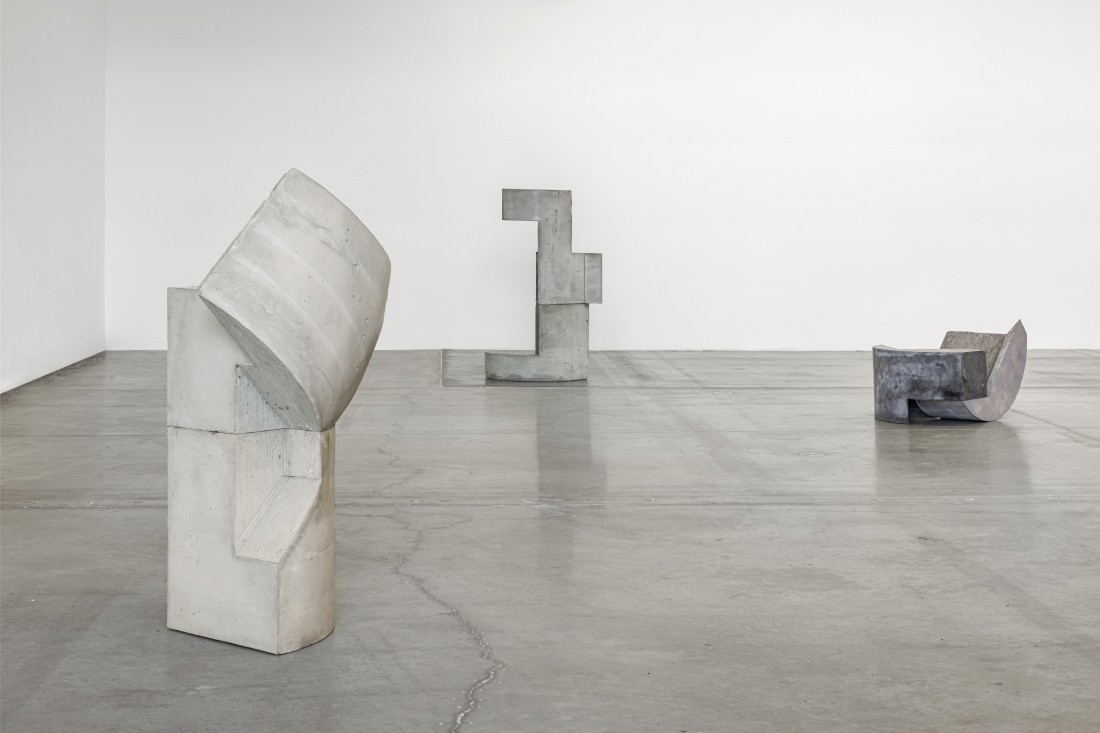Jen Aitken
While Toronto-based artist Jen Aitken’s exhibition of concrete, fibreglass and wood sculpture and stop-motion animation 3-channel video sharply departs from the identitarian work The Power Plant has focused on over the last decade, it aligns perfectly with the gallery’s surrounding built environment: the bleak line of condos along Toronto’s Harbourfront, lookalike concrete tombs marking the death of a livable green waterfront. The exhibition’s title, “The Same Thing Looks Different,” highlights the artist’s rendering of brutalistinformed architectural material in abstract forms, making familiar structures strange, thus encouraging viewers to look closer at their surrounding environments. Along with urban architecture, however, Aitken’s artwork has a second focus: the relationship between the viewer’s body and her artwork, a relationship established through material and form.

Jen Aitken, Lunopel, 2016, concrete and foam. Collection of the Art Gallery of Ontario, Toronto. Anonymous gift, 2023. Courtesy The Power Plant, Toronto. Photo: Toni Hafkenscheid.
Aitken’s first time-based piece, the immersive Lexicon!, 2023, serves as an introduction to the exhibited sculptures’ geometric forms. The artist used stop-motion animation techniques to render shapes that morph into others against a sonic backdrop of abstracted sound recordings. Large-scale projections covering three walls enclosed viewers, immersing them in the installation. In contrast, the exhibited sculptures encourage viewers to look outward, prompting circumnavigation through the gallery space to engage with the concrete environment both inside and outside the gallery.
Most directly incorporating the gallery space into the work are two plywood sculptures related to the “Wire Drawing” series, 2019 and ongoing. These sculptures do not use wire but, instead, plywood as if it were pliable. Like a children’s art class exercise in which you draw without removing the pencil from the paper, the sculptures form a continuous plywood loop. These sprawling sculptures (dimensions ranging from 7 to 12 feet) project from a corner (Outline 1, 2023) or from the ceiling (Outline 2, 2023), their shapes changing depending on the sightlines and the viewer’s distance from the work, becoming more unified and geometric at a distance. Thus, they encourage the viewer to perceptually complete the sculptures and to be aware of their physical presence in a gallery context. They reinforce overriding themes of engagement and context but do not point outside the gallery.
Conversely, the floor sculptures, whose simplified forms and media Aitken has drawn from architecture (fibreglass, foam and concrete), do point outward. While their spare architectural shapes indicate minimalism, their directing to the external environment—the gallery, its surroundings and Ontario brutalist architecture—separates them from that movement’s insular formalism. Engaging the viewer and connecting them to their environs, the floor sculptures form the exhibition’s conceptual core.
Commissioned by The Power Plant for this exhibition, the three fibreglass works are of near human-sized scale. Their epoxy resin and fibreglass cloth material lend them skin-like surfaces linking them to viewers’ bodies. Under five feet high, the sculptures are only slightly smaller than the human body, further analogizing them to the corporeal. Even more than their forms, their titles, for example, Altered Cylinder B (Crouching), 2023, are anthropomorphic for indicating human movement. Although this piece’s curved form may hint at crouching, that association might not have been made without the title’s guidance. The piece could just as easily allude to a curved staircase.

Installation view, “The Same Thing Looks Different,” 2023, The Power Plant, Toronto. Photo: Toni Hafkenscheid. Left to right: Ellocape, 2019, concrete and foam. Private collection. Yna, 2016, concrete and foam. Private collection. Oppik, 2016, concrete and foam. Courtesy the artist; Nicholas Metivier Gallery, Toronto; and TrépanierBaer, Calgary.
The fibreglass sculptures have two distinct sides, one open and one closed, with the hollowed sides creating a negative space. Consequently, they paradoxically offer openness and closure, inviting a connection with viewers via scale, but do not allow for circumambulation or any other involvement in the work through movement.
More effective in engagement are five concrete floor sculptures from two older series, “Capal,” 2019, and “Numa,” 2015–16, which offer full, two-sided views. Built urban environments, notably regional brutalist architecture, inform them. Aitken here is interested in the contrast between direct references to common materials in the urban milieu and unusual, non-referencing or vaguely referencing abstract forms lacking utilitarian purpose. The sculptures are just under four feet high at their tallest, rendering them strange and alienating because, except for scale, they evoke edifices and large complexes: the iconic brutalist-influenced landmarks of Toronto, the CN Tower, Robarts Library and less-known, often institutional architecture—the University of Toronto’s Scarborough campus, for example. Yna, 2016, the most straightforwardly architectural of the series, has a flag-like shape arising from a cylindrical base that subtly echoes Robarts Library’s exterior design.
Yna exemplifies this exhibition’s greatest strength: its invitation to viewers to look more closely at the built environment of Toronto and other cities, whether gentrified zones like Harbourfront or modernist edifices and institutions. The sculptures draw viewers not only to their bodies and their bodies’ positionings but also to their meta environment. One question regarding the latter remains: Is architectural signification without commentary a strong enough exhibition premise more than half a century after Donald Judd, Gordon Matta-Clark, Dan Graham, et al. linked art to architecture? ❚
“Jen Aitken: The Same Thing Looks Different” was exhibited at The Power Plant, Toronto, from June 23, 2023, to September 4, 2023.
Earl Miller is an independent art writer residing in Toronto.

